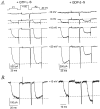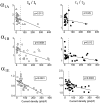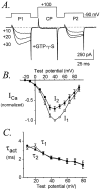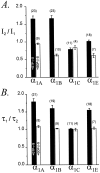G-Protein-dependent facilitation of neuronal alpha1A, alpha1B, and alpha1E Ca channels
- PMID: 9651207
- PMCID: PMC6793477
- DOI: 10.1523/JNEUROSCI.18-14-05240.1998
G-Protein-dependent facilitation of neuronal alpha1A, alpha1B, and alpha1E Ca channels
Abstract
Modulation of neuronal voltage-gated Ca channels has important implications for synaptic function. To investigate the mechanisms of Ca channel modulation, we compared the G-protein-dependent facilitation of three neuronal Ca channels. alpha1A, alpha1B, or alpha1E subunits were transiently coexpressed with alpha2-deltab and beta3 subunits in HEK293 cells, and whole-cell currents were recorded. After intracellular dialysis with GTPgammaS, strongly depolarized conditioning pulses facilitated currents mediated by each Ca channel type. The magnitude of facilitation depended on current density, with low-density currents being most strongly facilitated and high-density currents often lacking facilitation. Facilitating depolarizations speeded channel activation approximately 1.7-fold for alpha1A and alpha1B and increased current amplitudes by the same proportion, demonstrating equivalent facilitation of G-protein-inhibited alpha1A and alpha1B channels. Inactivation typically obscured facilitation of alpha1E current amplitudes, but the activation kinetics of alpha1E currents showed consistent and pronounced G-protein-dependent facilitation. The onset and decay of facilitation had the same kinetics for alpha1A, alpha1B, and alpha1E, suggesting that Gbeta gamma dimers dissociate from and reassociate with these Ca channels at very similar rates. To investigate the structural basis for N-type Ca channel modulation, we expressed a mutant of alpha1B missing large segments of the II-III loop and C terminus. This deletion mutant exhibited undiminished G-protein-dependent facilitation, demonstrating that a Gbeta gamma interaction site recently identified within the C terminus of alpha1E is not required for modulation of alpha1B.
Figures











Similar articles
-
Regulation of human neuronal calcium channels by G protein betagamma subunits expressed in human embryonic kidney 293 cells.Mol Pharmacol. 1997 Aug;52(2):282-91. doi: 10.1124/mol.52.2.282. Mol Pharmacol. 1997. PMID: 9271351
-
Selective G-protein regulation of neuronal calcium channels.J Neurosci. 1996 Aug 1;16(15):4617-24. doi: 10.1523/JNEUROSCI.16-15-04617.1996. J Neurosci. 1996. PMID: 8764650 Free PMC article.
-
Facilitation of rabbit alpha1B calcium channels: involvement of endogenous Gbetagamma subunits.J Physiol. 1998 May 15;509 ( Pt 1)(Pt 1):15-27. doi: 10.1111/j.1469-7793.1998.015bo.x. J Physiol. 1998. PMID: 9547377 Free PMC article.
-
The modulation of calcium currents by the activation of mGluRs. Functional implications.Mol Neurobiol. 1996 Aug;13(1):81-95. doi: 10.1007/BF02740753. Mol Neurobiol. 1996. PMID: 8892337 Review.
-
Voltage-dependent calcium channels.Gen Physiol Biophys. 2005 Jun;24 Suppl 1:1-78. Gen Physiol Biophys. 2005. PMID: 16096350 Review.
Cited by
-
Identification and characterization of novel human Ca(v)2.2 (alpha 1B) calcium channel variants lacking the synaptic protein interaction site.J Neurosci. 2002 Jan 1;22(1):82-92. doi: 10.1523/JNEUROSCI.22-01-00082.2002. J Neurosci. 2002. PMID: 11756491 Free PMC article.
-
Differential facilitation of N- and P/Q-type calcium channels during trains of action potential-like waveforms.J Physiol. 2002 Mar 1;539(Pt 2):419-31. doi: 10.1113/jphysiol.2001.013206. J Physiol. 2002. PMID: 11882675 Free PMC article.
-
Regulators of G protein signaling attenuate the G protein-mediated inhibition of N-type Ca channels.J Gen Physiol. 1999 Jan;113(1):97-110. doi: 10.1085/jgp.113.1.97. J Gen Physiol. 1999. PMID: 9874691 Free PMC article.
-
Neurotransmitter modulation of neuronal calcium channels.J Bioenerg Biomembr. 2003 Dec;35(6):477-89. doi: 10.1023/b:jobb.0000008021.55853.18. J Bioenerg Biomembr. 2003. PMID: 15000517 Review.
-
Identification of CaV channel types expressed in muscle afferent neurons.J Neurophysiol. 2013 Oct;110(7):1535-43. doi: 10.1152/jn.00069.2013. Epub 2013 Jul 10. J Neurophysiol. 2013. PMID: 23843437 Free PMC article.
References
-
- Bean BP. Neurotransmitter inhibition of neuronal calcium currents by changes in channel voltage dependence. Nature. 1989;340:153–156. - PubMed
-
- Bernheim L, Beech DJ, Hille B. A diffusible second messenger mediates one of the pathways coupling receptors to calcium channels in rat sympathetic neurons. Neuron. 1991;6:859–867. - PubMed
Publication types
MeSH terms
Substances
Grants and funding
LinkOut - more resources
Full Text Sources
